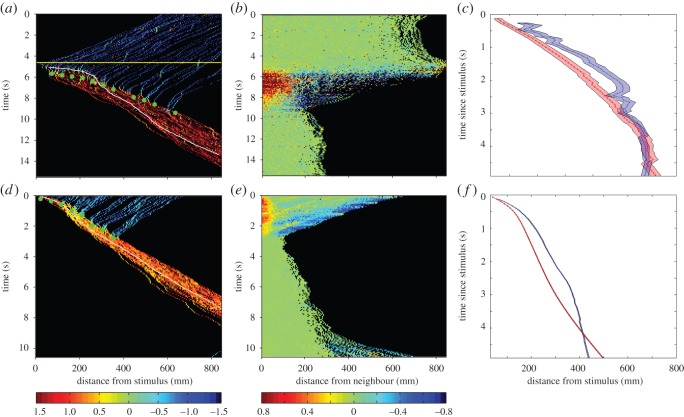Figure 1.
Examples of the dynamics of information transfer in an experimental trial with 51 fish (a–c) and a model simulation (d–f) with 51 particles. (a) Each fish's angular coordinate (in a polar coordinate system with the centre of the arena as a pole and the radius going through the stimulus position as a polar axis) is represented by a colour-coded point. The colour bar below this figure and in (d) indicates values in radians, representing a fish's angle relative to the radius χ: individuals in deep blue are moving perpendicularly to the radius and moving in the CW direction, fish in red are oriented perpendicular to the radius but moving anti-CW, and fish in green are moving in a parallel direction to the radius (see Material and methods for details). As the trial progresses in time ( y-axis), the fish get closer to the stimulus until the stimulus enters the arena (yellow horizontal line). A clear escape response develops, with all individuals moving away from the stimulus. The green circles indicate the position of the escape wave, defined as 10-degree sectors shifting for the first time from a negative to a positive average alignment. The white line shows the trajectory of the first fish to respond to the stimulus. (b) Velocity fluctuations (see Material and methods, see colour bar below this figure and (e)) measured as a function of distance during the trial. These are uncorrelated before attack, positively correlated at shorter distances and anticorrelated at greater distances during the attack, but uncorrelated following the attack. The points at which the velocity fluctuations reach zero indicate the group's correlation length. (c) Average position of the first responding individual (red) and the average position of the escape wave (blue) averaged across all experiments. (d) Colour coding and measurements as in (a) but for a model simulation. The model shows the same qualitative dynamics as the experimental example in (a). (e) Velocity fluctuations in the model simulation, again showing consistent dynamics to the experimental results. Colour coding as in (d). (f) Average position of the informed individuals and the escape wave as in (c), but here for model simulations.

